Warsaw Monuments
It is believed that Poles love to raise monuments. Well, Warsaw monuments are indeed numerous, so let us check some of the most known or most interesting. Many of them are conveniently situated on the Royal Route.
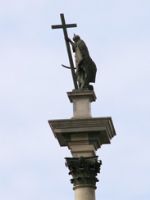
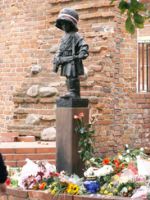
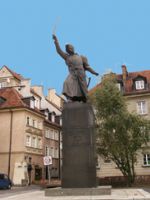
On the Castle Square rises 22 meters high statue of the king
Sigismund III Waza, the oldest secular statue in the city. This monument of the king, who moved the capital from Cracow to Warsaw, was founded by his son in 1644. In 1939 the column collapsed under German bombs, its remains lies now close to the
Royal Castle - and it is believed that touching it brings luck. The figure itself survived the war and the monument was proudly re-erected in 1949.
At Podwale we have a statue of Warsaw shoemaker
Jan Kilinski, a hero who fought Russians along with Kosciuszko during the Uprising in 1794.
The Old Town was a place of heavy fights during the Warsaw Uprising 1944.
Wandering along the city walls we can come across a bronze figure of a
boy-soldier. This is a monument to all those children that fought during the Uprising along with the grown-ups.
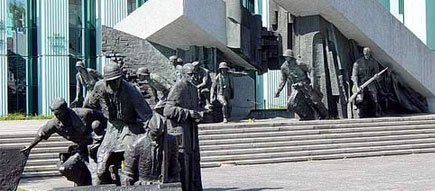 The monument over the heroes of the Warsaw Uprising
The monument over the heroes of the Warsaw Uprising, on the Krasinskich Square, still evokes mixed feelings, as it did in 1988 when its intended form had been revealed to the public. Many consider it as pretentious and twisting the truth about the uprising. The monument is placed near to the former entrance to underground sewage, that the Home Army soldiers was forced to use in order to move around the area.
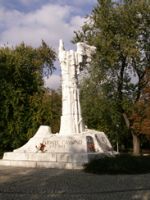
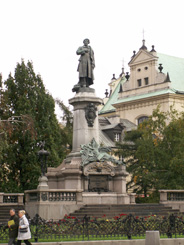
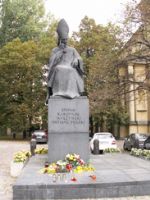
In the far end of the neighbouring
Krasinskich Garden, there is a monument over those Polish soldiers of the Polish Army fighting along the allies troops, that conquered
Monte Cassino in May 1944. This Italian monastery on the hill was a Nazi post blocking the Allies’ advance toward Rome and the battle was significant for the World War II outcome.
Several sculptures over famous Poles are situated along Krakowskie Przedmiescie: the statue of
Adam Mickiewicz, poet and patriot, who is considered as the greatest figure in Polish literature, is standing on its pedestal at a little square. We have another writer in bronze further on –
Boleslaw Prus, and a bit further more - the statue of Catholic Cardinal
Stefan Wyszynski, who was imprisoned by the communists who feared his greatness and influence on Polish people.
Turning back on the track, outside the
Presidential Palace there is a statue of another man with a weapon in hand - Duke Jozef Poniatowski, made by the famous Danish sculptor Berthel Thordwaldsen. The original was completely destroyed during the World War II, so this is a copy, founded by the kind citizens of Copenhagen.
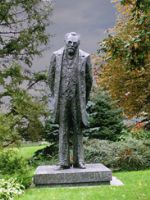
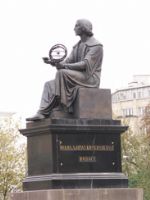
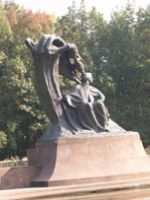
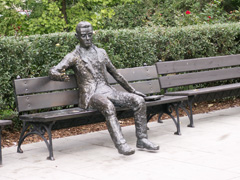
Heading towards the next monument – of
Nicolai Copernicus (
Mikolaj Kopernik) – we can make a quick detour into the University area and have a look at the statue of… a
student. He is sitting on a bench outside the former University library.
The statue of Copernicus, founder of the modern astronomy is sculptured by Berthel Thordwaldsen. It was founded 1830 by the same man who founded the palace behind - Stanislaw Staszic, the leader of Polish movement of Enlightenment.
During World War II the Nazis covered the inscription in Latin on the pedestal with a bronze plaque in German, insinuating that Copernicus was German. In 1942, a boy scout Alek Dawidowski secretely removed the plaque. Infuriated, the Nazis removed the whole statue, hid it somewhere in Silesia aiming to destroy it, and in revenge took away and hide the statue of Kilinski. The Home Army quickly found out that the statue was hidden in the vaults of the National Museum and announced it with a funny graffiti on its wall.
The statue of Copernicus was luckily recovered after war and placed back where it belongs.
The monument of another great Pole -
Fryderyk Chopin - is probably, along the one of Sigismund III Waza, the best known Warsaw monument in the world. Made in art deco style by Wladyslaw Szymanowski, it was unveiled in 1926. Destroyed by the Nazis, it was reconstructed so it could reappear in Lazienki Park in 1958.
Staying for a while in
Lazienki Park - just outside its north gates, at charming Agrykola street, there is another quite well known statue of king
Jan III Sobieski, who played a significant role in stoping the Otoman Imperium to overtaking Vienna in 1693. And in Lazienki, behind the Old Orangery building (
Stara Pomaranczarnia), one can spot a stone figure of a resting dog. This monument war raised on the former burial place of all dogs in service at the royal court. Those were the times...
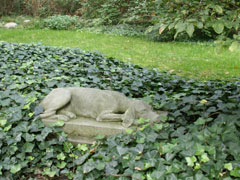
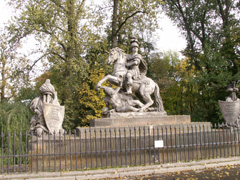
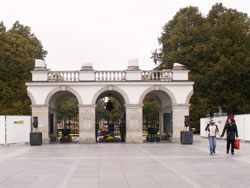
Back on the track in the busy downtown, and again tracing signs of the tragic Polish history, when we turn right from Krakowskie Przedmiescie towards The Pilsudski Square, we can visit
The Tomb of The Unknown Soldier. It is situated in the only remains of 17th century Saski Palace, blown up by the Nazis. The tomb was established in 1925, and now there are 24 urns with ashes of unknown Polish soldiers from battlefields all over Europe placed there.
On the square we have also the statue of marshal
Jozef Pilsudski, unveiled in 1995. Pilsudski was a great patriot, who fought for Polish independence during World War I and later became a head of the Polish state. He was also mastermind behind the victory over Bolsheviks at outskirts of Warsaw in 1920, that saved young Poland - and Europe - from being overtaken by the communists. Woodrow Wilson described this battle as the ‘seventh most important battle in history’.
To express its gratitude, Warsaw founded Pilsudski another monument (on the picture below), placed close to
The Belveder Palace. By the way, also
Charles de Gaulle got, besides the Virtuti Militari medal, his own statue for his role played in the same battle. The statue is situated outside the former Communist Party Quarter, today the stock exchange house.
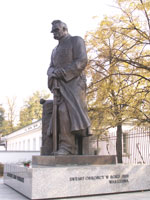
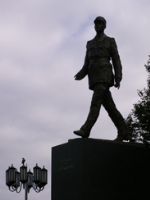
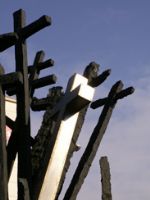
On the intersection of Muranowska and Andersa Street, not far from the
New Town, there is a
Monument for the Fallen and Murdered in the East, commemorating all the victims of the Soviets who after they had invaded Poland in 1939, deported the population of Eastern Poland to Gulags and killed about 30 000 P.o.W in Katyn. The bronze cast monument includes a piece of a railway track and a wagon similar to those used by the Soviets for deportations. Numerous symbols representing the ethnic and religious mixture that used to populate Polands Easter Borderland were placed on the wagon, along with the names of the places emptied of the Poles.
Heading from there, towards the former Jewish quarters, we will find
Umschlagplatz, and at the Zamenhof Square - the
Monument over the Heroes of the Jewish Ghetto. Read more about those monuments under "
Jewish Sites".